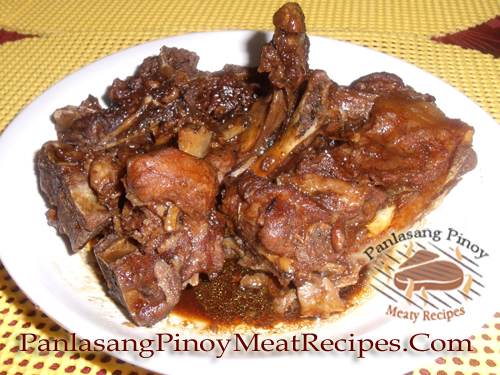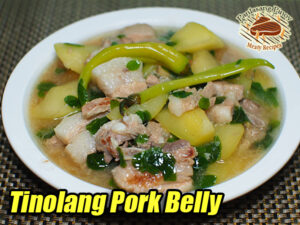Adobo is one of the most popular Filipino dish and there are many varieties of adobo you can find in Filipino cuisine. The usual pork adobo you can find is pork shoulder or pork belly which is tasty because it includes the meat with the fat. But pork ribs is even tastier when you cook it into a pork ribs adobo dish because the bones ads zest to the dish. If adobo is your favorite dish, I’m sure this is a must try.
Pork Ribs Adobo: A Flavorful Twist on a Filipino Classic
Whenever I smell pork adobo simmering in my kitchen, I’m transported back to countless family gatherings, where everyone around the table would be sharing laughs and scooping up tender pork adobo with heaps of rice. Adobo has been a Filipino staple for generations, and each family seems to have their own unique version. Traditionally, the most popular cuts are pork belly or shoulder, which add richness due to their marbled fat. But I’ll let you in on a family secret—my Tita Aida swears by pork ribs for an extra layer of flavor. The bones in the ribs infuse a subtle depth that makes each bite truly special.
What Makes Pork Ribs Perfect for Pork Ribs Adobo
Adobo is a dish that thrives on the balance of flavors—salty, tangy, garlicky, with a hint of sweetness. The pork ribs bring a unique twist to this Filipino favorite. Thanks to the bones in the ribs, which add their own savory richness as they simmer, the flavor becomes more pronounced and hearty. My cousin Junjun, who’s always been the family’s unofficial “taste tester,” says the secret lies in how the bones soak up all the savory goodness, making each bite incredibly flavorful.
Another reason why pork ribs work so well in pork ribs adobo is because of their structure. Unlike fattier cuts, pork ribs have just enough meat and fat to become tender without getting overly oily. This is especially wonderful when you’re sharing the dish with family or friends because the flavors are deeply infused but light enough to be enjoyed in hearty portions.
A Brief Look at the Roots of Adobo
Adobo is one of those dishes that every Filipino knows by heart, and yet each household has a version that’s slightly different. The word “adobo” itself comes from the Spanish term for marinade or seasoning, but Filipino adobo is something uniquely ours. While the Spanish influence might have inspired the name, adobo was already a staple in the Philippines long before. Filipinos used vinegar and salt as a natural preservative, perfect for island living. This classic method of preserving food has transformed into what we now know and love as adobo.
Over the years, adobo has evolved with countless varieties. From chicken to seafood to even vegetable adobo, each version has its own story. For me, pork ribs adobo has a special place because it’s one of those dishes I grew up eating during family get-togethers, where my uncles would each debate their version of “the right adobo.”
Preparing Pork Ribs Adobo: Key Steps for Maximum Flavor
The first step in making pork ribs adobo might surprise beginners, but it’s one of the reasons this dish has such a clean and robust flavor. Soaking the pork ribs in water for at least 30 minutes removes any blood and the strong pork odor. My Uncle Rodel taught me this trick, explaining that this simple step makes the final dish taste purer, allowing the flavors of the marinade to shine. It’s a small detail, but it makes all the difference, especially if you’re using bone-in pork ribs which tend to have a stronger flavor than other cuts.
Once the ribs are clean and ready, the next step is to let them simmer with all the essential ingredients: soy sauce, vinegar, garlic, onions, bay leaves, a touch of sugar, black pepper, and some granulated seasoning. Each ingredient plays a specific role. The vinegar and soy sauce are the core of any adobo, giving it that characteristic salty-sour taste, while the garlic and bay leaves add depth and warmth. Adding a bit of sugar balances the tangy notes, giving the dish a gentle sweetness that makes the pork even more irresistible. My mother would often say that the sugar “takes the edge off” the vinegar, making it perfect for those who prefer a more rounded taste.
The Art of Slow Cooking: Why Patience is Key
One thing about adobo, especially with pork ribs, is that it needs time to reach its peak flavor. After adding all the ingredients, bring the pot to a gentle boil before reducing the heat. Cooking on medium-high heat for about an hour helps the ribs become tender and infuses every bite with the essence of the marinade. My Lola’s advice has always been to “let the meat fall off the bone,” and it’s true—good pork ribs adobo should be tender but not mushy. Keep an eye on the liquid, and if it reduces too quickly, add a bit of water to prevent the dish from drying out.
By the end of cooking, the sauce should have reduced to a rich, glossy coating on the ribs, about one cup or less, thickened just enough to cling to each piece of meat. If the liquid is too thin, you can let it simmer a bit longer, but be careful not to overdo it, as you want to retain enough sauce to mix with steamed rice.
Serving Pork Ribs Adobo: A Simple yet Heartwarming Meal
For me, there’s no better way to serve pork ribs adobo than hot from the pot, ladled generously over freshly steamed rice. The sauce, tangy and savory, soaks into the rice, creating a perfect balance of flavors. Sometimes, if I’m feeling a bit nostalgic, I’ll garnish it with a sprinkle of fried garlic on top, just like my family does for special occasions. It adds a little crunch and extra aroma that’s hard to resist.
Pork ribs adobo has become a go-to in my family for a reason—it’s comfort food, plain and simple, but with layers of flavor that make it feel like a celebration. Whether you’re making it for the first time or the hundredth, there’s always something special in that first bite. So if you’re looking for a twist on traditional pork adobo, give pork ribs a try. You’ll discover a depth of flavor that’s both familiar and refreshingly new, a tribute to the way food connects us to our roots and loved ones.
How to Cook Pork Ribs Adobo
Equipment
- cooking pot
Ingredients
- 1 kilo pork ribs e.g. baby back ribs or spare ribs
- 1/4 cup soy sauce
- 1/4 cup vinegar
- 3 piece bay leaves
- 1 Tbsp. brown sugar
- 1 medium size onion chopped
- 6 cloves garlic minced
- 1/2 tsp. ground black pepper
- 1/2 tsp. granulated seasoning e.g., Magic Sarap, NamNam
- 3 cups water
Instructions
How to cook Pork Ribs Adobo:
- Soak the chopped pork ribs in water for at least 30 minutes to remove the blood and odor.
- Strain the pork ribs and put in pot. Then add soy sauce, vinegar, garlic, onion, bay leaf, sugar, pepper, granulated seasoning and water.
- Cook in a medium high heat for about 1 hour or until the pork is tender and the liquid has evaporated to 1 cup or less.
- Just check the adobo while cooking if the liquid has dried up and add water if necessary to avoid burning the dish.
- Serve hot with steamed rice.
Video
Notes
Cooking Tips for Pork Ribs Adobo:
Soak the Pork Ribs for Cleaner Flavor
Before cooking, soak the pork ribs in water for at least 30 minutes to remove any blood and reduce the strong pork aroma. This simple step ensures a cleaner, purer taste in the final dish, allowing the adobo flavors to shine through. Skipping this step may result in a gamey aftertaste, so don’t rush the soaking process.Simmer Slowly for Tender Meat
Adobo is best when cooked low and slow, allowing the flavors to fully penetrate the meat and make the ribs tender. Cooking on medium-high heat for about an hour helps break down the meat’s collagen, creating a melt-in-your-mouth texture. Keep an eye on the liquid level, adding water if necessary, to prevent drying out or burning.Let the Sauce Reduce for a Richer Flavor
The key to a flavorful adobo sauce is reducing the liquid until it’s thick and clings to the ribs. As the sauce reduces, it becomes concentrated, intensifying the savory, tangy, and slightly sweet flavors. Aim for about one cup or less of sauce at the end, perfect for pouring over steamed rice without making it too watery.






Thanks for the recipe..
Yan po ang lulutuin ko ngaun..
Hi Lorna, you are welcome! Hope you will also try other recipes in this blog.
Thanks for this pork ribs adobo recipe! I’ve been looking for other ways to cook the spareribs I bought yesterday.
Hi Tony, thanks also for visiting this blog and your comment!